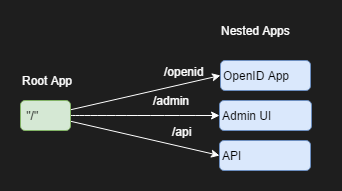-
Using Pulumi with multiple accounts
When logging into Pulumi, using
pulumi loginthe effect is machine wide. If, like me, you have multiple accounts i.e. personal and work, switching accounts by logging out and logging back in again becomes tedious fast. It's also risky when you find yourself logged into the wrong account and you do apulumi up... -
ProxyKit - Last release and EOL.
At end of last year I pushed version
2.3.4of ProxyKit to nuget.org which I expect to be the final version. -
AspNet Core 3.1 Nested Applications
This is a follow up on a previous post about how to host multiple isolated ASP.NET core applications in a single process with with a single http listener/entry. The techniques used in that post used types and classes e.g.
Microsoft.AspNetCore.Hosting.Internal.StartupLoaderthat have been madeinternalin ASP.NET Core 3.x and thus the approach is no longer viable.Instead we need to take a different approach that, while has some caveats, works well.
-
AspNet Core Nested Applications
Given any application of a reasonable size, to reason about it and manage complexity one generally applies modular programming along clear and well defined boundaries. Recently I was seeking to do this with AspNet Core where I wanted to compose several independent applications, potentially developed by separate teams, within the one host.

Out-of-the box this is achieved with middleware, however this still means there is a single dependency injection container whose service registration code gets large and leaky. Occasionally there were classes and configurations that clashed. While useful for a lot of scenarios, AspNetCore middleware wasn't giving me the isolation I desired: defined controllers, own static content, auth middleware settings, independent policy definition, focused service registration and more. Basically I want multiple StartUp classes representing the different applications and connect them to a path in a host application.
Prior to AspNet Core this was easy to achieve with OWIN. Nested applications were just an
AppFuncthat you build and connected when wiring up an anapp.MapPath("path", appFunc). With AspNet.Core we need to take another approach. -
Commercial Suicide - Integration at the Database Level
This post was originally authored by Jak Charlton in 2009 and is originally hosted at devlicio.us. That site appears to be inactive and regularly unavailable so, with permission, I'm re-publishing it here as I think it's a timeless piece.
There are many ways you can commit commercial suicide, but there is possibly no slower and more agonising death than that produced by attempting that great architectural objective, the single authoritative database to which all applications talk.
The theory is good, if we have a single database then we have all our business information in one place, accessible to all, easy to report against, reduced maintenance costs, consistency across all applications, and a host of other good objectives.
However all these noble ideals hide a more fundamental problem, that the single database does not solve any of them, and makes most of them into far bigger problems.